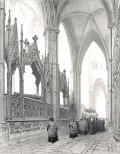
Inside of Westminster Abbey, with Funeral Procession
Nash, Frederick
1811
Artwork Information
-
Title:
Inside of Westminster Abbey, with Funeral Procession
-
Artist:
Nash, Frederick
-
Artist Bio:
British, 1782–1856
-
Date:
1811
-
Medium:
Watercolor, gouache, and graphite on paper
-
Dimensions:
40 x 30 7/8 inches
-
Credit Line:
Wichita Art Museum, Museum purchase, Friends of the Wichita Art Museum
-
Object Number:
1984.4
-
Display:
Not Currently on Display
About the Artwork
This large watercolor painting titled Inside of Westminster Abbey, with Funeral Procession was executed in 1811 by the British artist Frederick Nash (1782-1856). The tranquil and somber mood appropriate for the subject is heightened by the vast space of the interior and the misty glow of light throughout the background and upper spaces of the composition.
Nash was widely recognized by many and by Turner in particular as the most outstanding architectural painter of his day, and certainly in the instance of this work he readily commands attention by virtue of his meticulous handling of the many bold and massive architectural forms and of the accoutrements of the Abbey interior. However, it is obvious here that he was as much concerned with the study of light and space as he was with either the architectural statement or the funeral procession theme. Indeed, what most imparts a masterful quality to this work is the exquisitely delicate and carefully controlled treatment of light as it floods the interior, dissolving forms in the distance and sharply defining shapes and textures in the foreground. And at the same time, of course, compositional interest is furnished by the lofty height and the sweeping diagonal spaces depicted and by the dramatic color contrasts of light and dark areas.
The Romantic spirit of the early 19th century with its mystical love of light and its reverence for the past — and most especially for the medieval past — is clearly expressed in this painting. And that turn of mind becomes understandable when we take into account that the period was one which experienced radical societal change due to the rapid development of industry and new technologies, and therefore often nostalgically looked back to what it regarded as a more secure and stable age. In this connection, architectural monuments of the past symbolically supplied a psychological need and thus frequently consumed the attention of many artists. But on the other hand, such artists as Nash were quite progressive and already at this early date were much concerned with the very aesthetic issues which later in the century were to become basic in investigating the impact of time on change or the powerful effect of light in defining reality. In that sense a painting such as this may be seen as a stage in the development of what would be the dominant impressionist manner of the last quarter of the century.
Frederick Nash was born in Lambeth in 1782 and spent his early years studying architectural drawing. Westminster Abbey was the setting that he chose for many of his most detailed works. But Nash also painted in open air, executing the same scene at various times of the day in order to explore the effects of varying light conditions on defining the changing character of the subject. He exhibited at the Royal Academy and was much admired by Benjamin West, the American-born president of the Royal Academy, for his “grand and pictorial sentiment”. Nash was also a member of the well-known Old Watercolour Society. He died in Brighton, England in 1856.